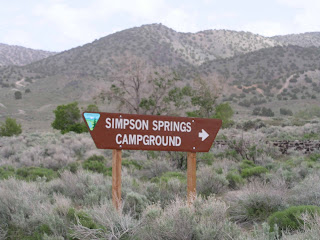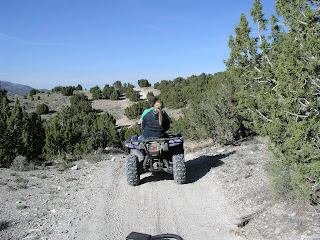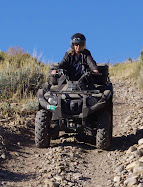 |
| Panorama of area near Simpson Springs |
We didn't stay and ride our ATVs at Simpson Springs, but the Utah BLM site http://www.blm.gov/ut/st/en/fo/salt_lake/recreation/camping/simspson_springs.html has information and a map of the area. According to the map, many of the trails are closed to motor vehicles.
Even though we didn't ride any trails at Simpson Springs, we took pictures of the site and will tell you a little about it.
 |
| Restored cabin at Simpson Springs |
A number of structures have been built and destroyed in the vicinity of Simpson Spring over the years, and it isn't known for sure which served as the station for the mail route and the Pony Express. This cabin is located at the approximate site of the original station and closely resembles the original. All information we tell here is written on signs around Simpson Springs.
One of the most dependable watering points in this desert region, Simpson Springs has long served man's needs. Indians used it, and early travelers and explorers counted on finding water here. It bears the name of one explorer, Captain J. H. Simpson, who stopped here in 1858 while searching for an overland mail route between Salt Lake City and California.George Chorpenning established a mail station at this site in 1858, which was later used by the Pony Express and Overland Express (the mail companies built small dams across the water course to improve the reliable, but limited, supply of water). When gold mining started west of here at Gold Hill in 1893, Simpson Springs took on new importance as a station for freighters and stages until the mid 1920's. In the 1930's, the spring became the water supply for a Civilian Conservation Corps Camp located south of here.
George Chorpenning did not benefit from the effort and money he spent building the mail stations. In 1859 financial troubles struck. Chorpenning's government mail contracts were suddenly reduced; no money reached route employees during the fall. Chorpenning's animals were "attached" and sold for back wages. William Russell acquired the new mail contract. Chorpenning notes that Russell "stepped in, hired my men, took possession of my stations, provisions, improvements..." Thanks to Chorpenning, the Pony Express was in business.









